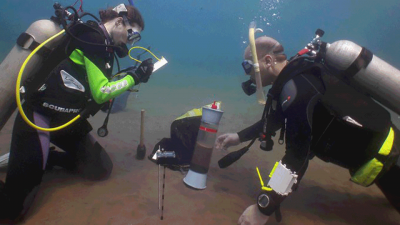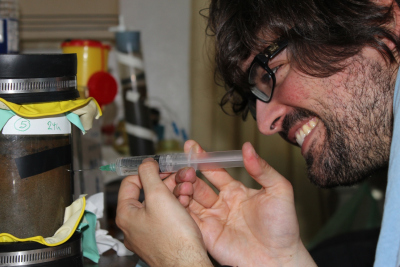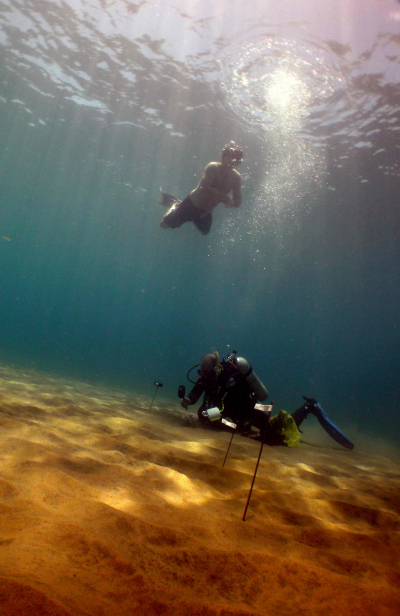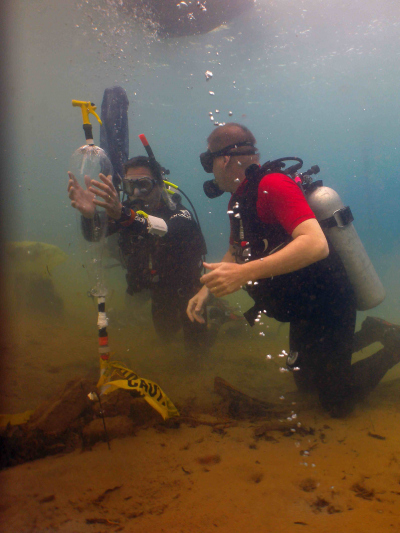Page path:
- Home
- Discover
- Archive News
- News 2013
- Hydrothermal Vents in the Caribbean
Hydrothermal Vents in the Caribbean
Hydrothermal Activity off Dominica, Lesser Antilles
Fascinating impressions and insights into a nearly unstudied marine environment off the Caribbean island of Dominica were gained on a recent international expedition headed by the MARUM scientist Dr. Solveig Bühring: “Highly active hydrothermal vents, which have been poorly studied so far, were discovered in less than 10 metres water depth. Most of the recent scientific interest on hydrothermal systems has focused on deep-sea vents. Off the Dominican coast, a volcanic system fuels an environment of solidified lava and sediments with hydrothermal fluids enriched with metals and toxics, like arsenic and sulfide, creating a habitat for microorganisms that are adapted to these extreme conditions.”
Initial results indeed reveal highly elevated concentrations of reduced iron (Fe2+) of up to 13ppm in the hydrothermal fluids, a rare characteristic for shallow vent systems. This reduced iron can be used by iron-oxidizing bacteria, a group of microbes that, because of their slow metabolism and their lack of lab representatives, have not been well studied. “With our investigations on the hydrothermal vents off Dominica, we hope to uncover the biogeochemical secrets of this and other exciting groups of microorganisms”, says Dr. Stefan Sievert from the US-American Woods Hole Oceanographic Institution.
Sampling on the hydrothermal vents of Dominica was done by diving, retrieving sediments using core liners, and collecting hydrothermal fluids and gases for subsequent geochemical analyses.
“For this research project, we collaborate with scientists from the United States and from the Jacobs University to cover diverse scientific aspects”, says principal investigator Solveig Bühring. “With our results, we hope to be able to decipher how the geochemical environment shapes the microbial community. Furthermore, we want to get insights into their lifestyles and their adaptations to these extreme conditions.”
Now the scientists have returned to their home laboratories and are excitedly working on processing the samples they brought back.
Fascinating impressions and insights into a nearly unstudied marine environment off the Caribbean island of Dominica were gained on a recent international expedition headed by the MARUM scientist Dr. Solveig Bühring: “Highly active hydrothermal vents, which have been poorly studied so far, were discovered in less than 10 metres water depth. Most of the recent scientific interest on hydrothermal systems has focused on deep-sea vents. Off the Dominican coast, a volcanic system fuels an environment of solidified lava and sediments with hydrothermal fluids enriched with metals and toxics, like arsenic and sulfide, creating a habitat for microorganisms that are adapted to these extreme conditions.”
Initial results indeed reveal highly elevated concentrations of reduced iron (Fe2+) of up to 13ppm in the hydrothermal fluids, a rare characteristic for shallow vent systems. This reduced iron can be used by iron-oxidizing bacteria, a group of microbes that, because of their slow metabolism and their lack of lab representatives, have not been well studied. “With our investigations on the hydrothermal vents off Dominica, we hope to uncover the biogeochemical secrets of this and other exciting groups of microorganisms”, says Dr. Stefan Sievert from the US-American Woods Hole Oceanographic Institution.
Sampling on the hydrothermal vents of Dominica was done by diving, retrieving sediments using core liners, and collecting hydrothermal fluids and gases for subsequent geochemical analyses.
“For this research project, we collaborate with scientists from the United States and from the Jacobs University to cover diverse scientific aspects”, says principal investigator Solveig Bühring. “With our results, we hope to be able to decipher how the geochemical environment shapes the microbial community. Furthermore, we want to get insights into their lifestyles and their adaptations to these extreme conditions.”
Now the scientists have returned to their home laboratories and are excitedly working on processing the samples they brought back.
Gonzalo Gomez Saez (MARUM) injecting a substrate that is marked with the stable carbon isotope 13C into a core which consists of hydrothermal sediments.






